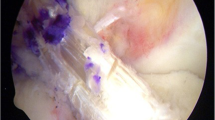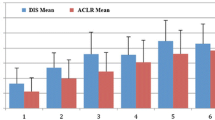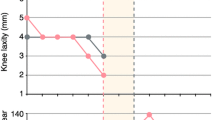Abstract
Purpose
Anterior cruciate ligament reconstruction (ACLR) in children is indicated to reduce recurrent knee instability and further damage to the joint. Postoperative modified gait pattern was reported in the adult population after ACLR. The aim of this study was to analyse gait abnormalities, and especially knee and ankle adaptations during gait in children after ACLR.
Methods
A prospective study was performed between 2018 and 2022 on 50 children, aged nine to 15 years with unilateral ACL deficiency. Changes in gait pattern were evaluated by gait analysis before surgery and at the latest follow-up of 24 months. Kinematic data of ACL-deficient limb were compared to contralateral limb and to those of a matched control group of healthy children.
Results
Compared to control group, knee flexion was decreased for both ACL-deficient and contralateral knee before surgery. Decreased knee flexion during gait cycle persisted at latest follow-up. Ankle kinematics showed decreased dorsal flexion for both ACL-deficient and contralateral limb before surgery. At latest follow-up, ankle kinematics were modified for ACL-reconstructed limbs only at initial contact and showed no significant difference for contralateral limb compared to the control group.
Conclusion
In children with ACL injury, abnormal gait patterns persist two years after ligament reconstruction, in spite of extensive rehabilitation and no clinical complaints. These findings might guide neuromuscular training to improve clinical outcomes and reduce the rerupture rate.







Similar content being viewed by others

Data availability
All data is available on demand.
References
Tellini Tamires L, Lima KO, Alouche SR, Bagesteiro LB (2013) Compliant surface after ACL reconstruction and its effects on gait. Acta Scientiarum 35:237–242
Wojtis Edward M, Brower Ashley M (2010) Anterior cruciate ligament injuries in the prepubescent and adolescent athlete. J Athl Train 45(5):509–512
Gao B, Cordova ML, Zheng NN (2012) Three-dimensional joint kinematics of ACL-deficient and ACL-reconstructed knees during star ascent and descent. Hum Mov Sci 31(1):222–235
Bulgheroni P, Bulgheroni MV, Andrini L, Guffanti P, Giughello A (1997) Gait patterns after anterior cruciate reconstruction. Knee Surg Sports Traumatol Arthrosc 5(1):14–21
Kocher MS, Saxon HS, Hovis WD, Hawkins RJ (2002) Management and complitations of anterior cruciate ligament injury in skeletally immature patients: survey of the Heridicus Society and The ACL Study Group. J Pediatr Orthop 22(4):452–457
Parkkari J, Panansen K, Mattila VM, Kannus P, Rimpela A (2008) The risk of cruciate ligament injury of the knee in adolescents and young adults: a population-based cohort study of 46,500 people with 9-year follow-up. Br J Sports Med 42(6):422–426
Millet PJ, Willis A, Warren RF (2002) Associated injuries in pediatric and adolescent anterior cruciate ligament tears: does a delay in delay increase the risk of meniscal tear? Arthroscopy 18(9):955–959
Roos EMR (2005) Joint injury causes knee osteoarthritis in young adults. Curr Opin Rheumatol 17(2):195–200
Werner BC, Yang S, Looney AM, Gwathmey FW (2015) Trends in pediatric and adolescent anterior cruciate ligament injury and reconstruction. J Pediatr Orthop. https://doi.org/10.1097/BPO.0000000000000482
Cassard X, Cavaignac E, Maubisson L, Bowen M (2014) Anaterior cruciate ligament reconstruction in children with a quadrupled semitendinosus graft: preliminary results with minimum 2 years of follow-up. J Pediatr Orthop 34(1):70–7711
Henry J, Chotel F, Chouteau J et al (2009) Rupture of the anterior cruciate ligament in children: early reconstruction with open physes or delayed reconstruction to skeletal maturity? Knee Surg Sports Traumatol Arthrosc 17(7):748–755
Vavken P, Murray MM (2011) Treating anterior cruciate ligament tears in skeletally immature patients. Arthroscopy 27:704–716
Aichroth PM, Patel DV, Zorilla P (2002) The natural history and treatment of rupture of the anterior cruciate ligament in children and adolescents. A prospective review. J Bone Joint Surg Br 84:38–41
Ursei ME, Accadbled F, Scandella M, Knorr G, Munzer C, Swider P, Briot J, Gauzy JS (2020Feb) Foot and ankle compensation for anterior cruciate ligament deficiency during gait in children. Orthop Traumatol Surg Res 106(1):179–183
Howell SM (1998) Principles for placing the tibial tunnel and avoiding roof impingement during reconstruction of a torn anterior cruciate ligament. Knee Surg Sports Traumatol Arthrosc 6(Suppl 1):S49-55
Berchuck M, Andriacchi TP, Bach BR, Reider B (1990) Gait adaptations by patients who have a deficient anterior cruciate ligament. J Bone Joint Surg Am 72A:871–877
Roberts CS, Rash GS, Honaker JT, Wachowiak MP, Shaw JC (1999) – A deficient anterior cruciate ligament does not lead to quadriceps avoidance gait. Gait Posture 10:189–1999
Hagood S, Solomonow M, Baarrata R et al (1990) The effect of joint velocity on the contribution of the antagonist musculature to knee stiffness and laxity. Am J Sports Med 18:182–187
Solomonow M, Barrata R, Zhou BH et al (1987) The synergistic action of the anterior cruciate ligament and thigh muscles in maintaining joint stability. Am J Sports Med 15:207–213
Huston LJ, Wojtys E (1996) Neuromuscular performance characteristics in elite female athletes. Am J Sports Med 24:427–434
Kimmel SA, Schwartz MH (2006) A baseline of dynamic muscle function during gait. Gait Posture 23:211–221
Lass P, Kaalund S, le Fevre S et al (1991) Muscle coordination following rupture of the anterior cruciate ligament. Electromyographic studies of 14 patients. Acta Orthop Scand 62:9–14
Wojtys EM, Huston LJ (1994) Neuromuscular performance in normal and anterior cruciate ligament-deficient lower extremities. Am J Sports Med 22:89–104
Hicks JL, Schwartz MH, Delp SL. Modelling and simulation of normal and pathological gait. In: Gage JR, Schwartz MH, Koop SE and Novacheck TF (eds) The identification and treatment of gait problems in cerebral palsy, 2nd edn, Mac Keith Press, p 285–288
Zhang LQ, Shiavi RG, Limbird TJ, Minorik JM (2003) Six degrees-of-freedom kinematics of ACL deficient-compensatory mechanism. Gait Posture 17:34–42
Funding
This study was supported by Zimmer Biomet.
Author information
Authors and Affiliations
Corresponding author
Ethics declarations
Ethical approval
Ethical approval was obtained from our local Institutional Review Board (RnIPH 2019–56).
Informed consent
Informed written informed consent was obtained from the parents of all patients included in the research.
Consent for publication
All authors consented to the submission of this manuscript.
Conflict of interest
Franck Accadbled has received speaker and consultant honoraria from Orthofix and Zimmer Biomet.
Additional information
Publisher's Note
Springer Nature remains neutral with regard to jurisdictional claims in published maps and institutional affiliations.
Rights and permissions
Springer Nature or its licensor (e.g. a society or other partner) holds exclusive rights to this article under a publishing agreement with the author(s) or other rightsholder(s); author self-archiving of the accepted manuscript version of this article is solely governed by the terms of such publishing agreement and applicable law.
About this article
Cite this article
Urseï, M., Briot, J., Scandella, M. et al. Changes in gait patterns after anterior cruciate ligament reconstruction in children. International Orthopaedics (SICOT) 48, 1517–1523 (2024). https://doi.org/10.1007/s00264-024-06108-5
Received:
Accepted:
Published:
Issue Date:
DOI: https://doi.org/10.1007/s00264-024-06108-5



